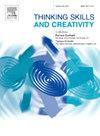用脑电图微状态法探讨学习者认知参与与学习活动的动态关系
IF 4.5
2区 教育学
Q1 Social Sciences
引用次数: 0
摘要
了解学习者的认知投入对培养高阶思维技能至关重要,因为它反映了学习者的思维发展过程。然而,目前尚不清楚不同类型的学习活动如何暂时调节认知参与。脑电图(EEG)微状态为理解大脑复杂的动态过程提供了一种方法,反映了认知活动的功能意义。在本研究中,我们基于互动-建构-主动-被动(ICAP)框架设计了三种不同类型的学习活动(即视频观看、关键词提取和论文创作)。收集了31名学生在参与这些活动时的脑电图数据。采用MS A、MS B、MS C和MS D四种典型的微观状态,探讨大脑认知参与与活动类型和学习阶段相关的动态特征。我们发现,MS A、MS B和MS C的特征在三种活动中有显著差异。同时,我们对每个活动的活动前、活动中和活动后进行了单独的分析。MS A、MS B和MS C在视频观看活动中表现出不同的特征,MS C和MS D在关键词提取活动中表现出不同的特征。然而,在写作活动中没有发现显著差异。这些发现表明,微状态特征可以提供具有动态时间结构的神经活动模式信息,用于探索学习者认知投入的变化。这种动态变化依赖于学习活动和相应的脑功能系统。此外,本研究为教师教育工作者设计有效的学习活动提供认知神经科学支持,以促进HOTS的发展。本文章由计算机程序翻译,如有差异,请以英文原文为准。
Exploring dynamics in learners’ cognitive engagement associated with learning activities using EEG microstate approach
Understanding the cognitive engagement of learners is essential for the cultivation of higher-order thinking skills (HOTS) as it reflects their thinking development process. However, it is unclear how cognitive engagement is temporally modulated by different types of learning activity. The electroencephalogram (EEG) microstate provides a methodology for understanding the complex dynamic processes of the brain and reflects the functional significance of cognitive activity. In this study, we designed three different types of learning activities (i.e., video-watching, keyword-extracting, and essay-creating) based on the Interactive-Constructive-Active-Passive (ICAP) framework. EEG data from thirty-one students were collected during the engagement of these activities. Four typical microstates (i.e., MS A, MS B, MS C, and MS D) were employed to explore the dynamic characteristics of cognitive engagement in the brain associated with activity type and learning stage. We found that the features of MS A, MS B, and MS C were significantly different among the three activities. Meanwhile, we performed individual analyses for the pre-activity, mid-activity, and post-activity of each activity. The features of MS A, MS B, and MS C were different during the video-watching activity, and MS C and MS D showed differences during the keyword-extracting activity. However, no significant difference was found during the essay-creating activity. These findings reveal that microstate features can provide information about neural activity patterns with the dynamic temporal structure for exploring changes in learners’ cognitive engagement. Such dynamic changes rely on learning activity and corresponding functional brain systems. Furthermore, this study provides cognitive neuroscience support for teacher educators to design effective learning activities to promote the development of HOTS.
求助全文
通过发布文献求助,成功后即可免费获取论文全文。
去求助
来源期刊

Thinking Skills and Creativity
EDUCATION & EDUCATIONAL RESEARCH-
CiteScore
6.40
自引率
16.20%
发文量
172
审稿时长
76 days
期刊介绍:
Thinking Skills and Creativity is a new journal providing a peer-reviewed forum for communication and debate for the community of researchers interested in teaching for thinking and creativity. Papers may represent a variety of theoretical perspectives and methodological approaches and may relate to any age level in a diversity of settings: formal and informal, education and work-based.
 求助内容:
求助内容: 应助结果提醒方式:
应助结果提醒方式:


